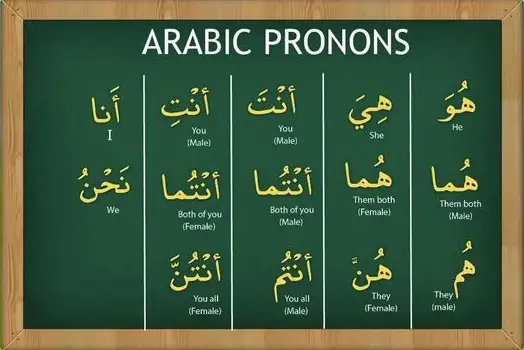Arabic pronouns are fundamental components of the language, helping to specify and clarify meaning in communication. This guide will take you through everything you need to know about Arabic pronouns, from their types to how they are used in sentences. Whether you are a beginner or looking to refine your understanding, this comprehensive guide will provide the insights you need.
Introduction
Have you ever thought about how often you use pronouns in your daily conversations? Words like “I,” “you,” “he,” and “she” are essential for clear communication. In Arabic, pronouns play a similar role but come with their unique set of rules and forms. This guide aims to demystify Arabic pronouns, making them approachable and easy to understand.
What Are Pronouns?
Pronouns are words used to replace nouns in a sentence, avoiding repetition and making sentences more concise. For example, instead of saying “Ahmed likes Ahmed’s book,” you say, “Ahmed likes his book.” In Arabic, pronouns are equally important and are used to ensure clarity and coherence in communication.
Types of Arabic Pronouns
Arabic pronouns can be broadly categorized into several types:
- Personal Pronouns: Used to refer to people or things.
- Demonstrative Pronouns: Used to point to specific things.
- Relative Pronouns: Used to connect clauses or sentences.
- Interrogative Pronouns: Used to ask questions.
- Possessive Pronouns: Used to show ownership.
Each type has its own set of rules and forms, which we will explore in detail.
Personal Pronouns
Personal pronouns in Arabic are used to refer to specific people or things and change based on gender, number, and person. Here are the basic forms:
- First Person:
- Singular: أنا (ana) – I
- Plural: نحن (naḥnu) – We
- Second Person:
- Masculine Singular: أنتَ (anta) – You
- Feminine Singular: أنتِ (anti) – You
- Dual: أنتما (antumā) – You two
- Masculine Plural: أنتم (antum) – You (all)
- Feminine Plural: أنتن (antunna) – You (all, female)
- Third Person:
- Masculine Singular: هو (huwa) – He
- Feminine Singular: هي (hiya) – She
- Dual: هما (humā) – They (two)
- Masculine Plural: هم (hum) – They
- Feminine Plural: هن (hunna) – They (female)
Demonstrative Pronouns
Demonstrative pronouns are used to point out specific things. They vary based on proximity (this/these vs. that/those) and gender.
- Near (This/These):
- Masculine Singular: هذا (hādhā) – This
- Feminine Singular: هذه (hādhihi) – This
- Dual: هذان (hādhān) – These two (masculine)
- Dual: هاتان (hātān) – These two (feminine)
- Masculine Plural: هؤلاء (hā’ulā’) – These
- Feminine Plural: هؤلاء (hā’ulā’) – These
- Far (That/Those):
- Masculine Singular: ذلك (dhālika) – That
- Feminine Singular: تلك (tilka) – That
- Dual: ذانك (dhānik) – Those two (masculine)
- Dual: تانك (tānik) – Those two (feminine)
- Masculine Plural: أولئك (ulā’ika) – Those
- Feminine Plural: أولئك (ulā’ika) – Those
Relative Pronouns
Relative pronouns are used to connect clauses and provide additional information about a noun mentioned earlier in the sentence.
- Who/That/Which:
- Singular: الذي (al-ladhī) – Who/That (masculine)
- Singular: التي (al-latī) – Who/That (feminine)
- Dual: اللذان (al-ladhān) – Who/That (masculine)
- Dual: اللتان (al-latān) – Who/That (feminine)
- Plural: الذين (al-ladhīna) – Who/That (masculine)
- Plural: اللواتي/اللاتي (al-lā’ātī/al-lā’ātī) – Who/That (feminine)
Interrogative Pronouns
Interrogative pronouns are used to ask questions about people or things.
- Who: من (man)
- What: ما (mā) / ماذا (mādhā)
- Which: أي (ayy)
Possessive Pronouns
Possessive pronouns show ownership and are usually attached to the noun they modify. The suffix changes based on the owner’s gender and number.
- First Person:
- My: ي (-ī)
- Our: نا (-nā)
- Second Person:
- Your (masculine): كَ (-ka)
- Your (feminine): كِ (-ki)
- Your (dual): كما (-kumā)
- Your (plural masculine): كم (-kum)
- Your (plural feminine): كن (-kunna)
- Third Person:
- His: ه (-hu)
- Her: ها (-hā)
- Their (dual): هما (-humā)
- Their (plural masculine): هم (-hum)
- Their (plural feminine): هن (-hunna)
Pronouns in Sentences
Understanding how to use pronouns in sentences is crucial. For example:
- أنا أدرس (ana adrusu) – I study.
- أنتَ تكتب (anta taktubu) – You (masculine) write.
- هي تقرأ (hiya taqra’u) – She reads.
- كتابك (kitābuka) – Your book.
These examples show how pronouns integrate into sentences, helping to convey clear meaning.
Pronouns and Verb Conjugation
In Arabic, pronouns are closely linked with verb conjugation. Each pronoun corresponds to a specific verb form. For example, the verb “to write” (يكتب – yaktubu) conjugates as:
- أنا أكتب (ana aktubu) – I write.
- نحن نكتب (naḥnu naktubu) – We write.
- هو يكتب (huwa yaktubu) – He writes.
- هي تكتب (hiya taktubu) – She writes.
Common Mistakes with Pronouns
Beginners often make these common mistakes:
- Mixing up genders: Using masculine pronouns for feminine subjects and vice versa.
- Incorrect suffixes: Adding the wrong suffix for possessive pronouns.
- Verb agreement: Not matching verbs correctly with pronouns in sentences.
Tips for Mastering Arabic Pronouns
- Practice Regularly: Use flashcards to memorize pronouns and their correct forms.
- Engage with Native Speakers: Practice using pronouns in conversation to reinforce your learning.
- Read Arabic Texts: Reading helps you see pronouns in context, aiding comprehension.
- Write Exercises: Write sentences using different pronouns to ensure you understand their use.
Conclusion
Arabic pronouns are essential for clear and accurate communication. By understanding and practicing their various forms and uses, you can significantly improve your proficiency in Arabic. Remember, consistent practice and exposure are key to mastering these fundamental elements of the language.
FAQs
What are the main types of Arabic pronouns?
The main types are personal, demonstrative, relative, interrogative, and possessive pronouns.
How do personal pronouns change in Arabic?
Personal pronouns change based on gender, number, and person. For example, “I” is “أنا” (ana) for singular and “نحن” (naḥnu) for plural.
What are possessive pronouns?
Possessive pronouns indicate ownership, such as “my,” “your,” “his,” “her,” “our,” and “their.” In Arabic, they vary based on the owner’s gender and number.
Can you provide an example of a relative pronoun in Arabic?
Certainly! An example of a relative pronoun in Arabic is “الذي” (al-ladhī), which translates to “who” or “that” in English.
How can I avoid common mistakes with Arabic pronouns?
To avoid common mistakes, practice regularly, pay attention to verb agreement, and seek feedback from native speakers or instructors.
Arabic pronouns are integral to the language’s structure and function. By mastering their forms and usage, you’ll enhance your ability to communicate effectively in Arabic. Whether you’re a beginner or seeking to refine your skills, understanding pronouns is a crucial step in your language journey.






